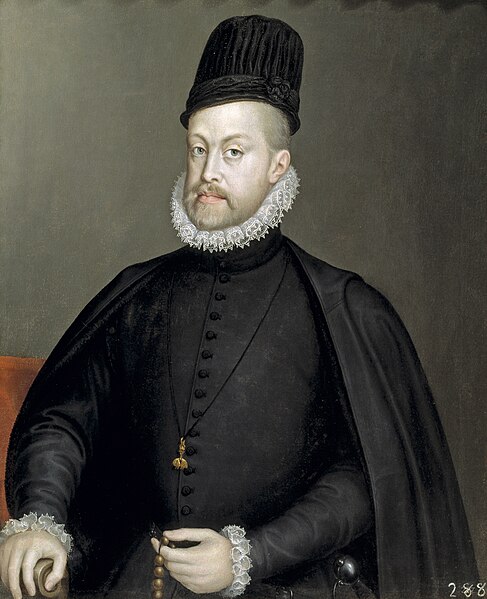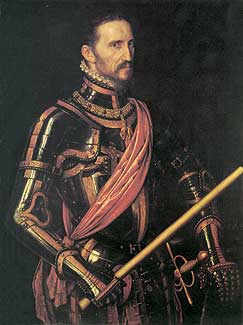 |
| Emblem of the Gueux |
The Gathering Storm
In April 1566 Louis and Brederode, at the head of 300
armed supporters, presented Margaret with a request demanding toleration[i].
One of Margaret’s court dismissed the petitioners as ‘beggars’ or ‘Gueux[ii]’. On 9th April Margaret
issued an order modifying the application of the heresy laws. She informed
Philip that his policies could not be implemented without violence. But within
the week she was to hear cries in the streets, ‘vivent les Gueux’.
The same week William, Egmont and Hoorn presented the
Regent with yet another ultimatum, the Compromis des Nobles; they would resign from the Council of
State if Philip did not give the council a greater voice in the affairs of the
Netherlands. In the matter of the Low Countries and religion, Philip was
inflexible, despite agreeing that a policy of toleration was suitable in
England[iii].
Early in April Elisabeth of Valois told courtiers that;
‘She knew the king, and he had told her often that he would never permit it
[toleration of religion] to his subjects, and would sooner renounce ruling over
them.’[iv]
The scene was set for a showdown between king and people.
The compromise attracted support from not just the Protestants but Catholics
also objected to Philip’s plans for religious bigotry.
Antwerp – the Birth of the Revolt
_-_View_of_the_Pier_of_Antwerp_from_the_Vlaams_Hoofd.jpg/800px-Bonaventura_Peeters_(I)_-_View_of_the_Pier_of_Antwerp_from_the_Vlaams_Hoofd.jpg) |
| Port of Antwerp |
The trouble began in Antwerp where Calvinism had taken a
strong hold. Beggars’ bowls and simulacrums thereof (earrings, brooches and
other jewellery) were for sale everywhere. In retaliation the Duke of Aarschot tried
to promote the wearing of medallions of the Virgin which did little to rouse
the faithful. Exiles started to return to support their oppressed brethren.
In May Brederode and his companions demanded that the
Antwerp town council give permission to preach freely; this permission was
denied in a town which had become a powder keg, armourers suddenly sold all
their stock. The Protestants held meetings outside Antwerp and attempts to prevent
them failed. In desperation Margaret called on William who was in Breda where
Anna was shortly due to give birth.
William set off for Antwerp in July and his arrival was a
triumphant procession. Dismayed at the reaction of the masses William informed
Brederode;
‘Have a care what you do or you will live to regret it.’[v]
 |
| Margaret of Parma |
William was torn by his duty to his king, although he
firmly believed that Philip’s position over religious toleration was wrong. He
was also acutely aware that at the source of the civil disobedience was the
rising price of food, shortage of jobs and declining trade; all in part, at
least, the results of Philip’s policies.
William called for the meetings outside town to be given
up and attended mass openly. His moderation swayed the town and as proof of his
sincerity William asked Anna to join him. En route Anna removed her
stepdaughter Maria from the Regent’s household, a grave insult to Margaret. It
was most unwelcome to William, who worried about the effect of Anna’s behaviour
on Maria. Maria was returned to the Regent’s care.
In early autumn the Knights of the Golden Fleece were
summonsed to Brussels and on 19th August 1566, the day on which
William rode out of the city, Antwerp erupted. The rest of the Netherlands were
not far behind. For five days Protestant supporters looted and/or destroyed a
number of monasteries and churches across the Netherlands; defacing or smashing
Catholic statues and religious objects.
The Aftermath
 |
| Philip II |
Margaret mistakenly believed the riots to be the work of
both the greater and lesser nobility and lost all faith in William and his
colleagues. She wrote to Philip who fell ill at the news. Always slow to come
to a decision, it took until the end of October for Philip to decide that a firmer hand
than Margaret’s was needed to suppress opposition to the Spanish crown. To
tackle both the civil and religious rebels an army was prepared and in November
Alba[vi] was chosen as its
commander[vii].
By the end of December the military were ready and Alba commented;
‘In this question of Flanders the issue is not one of taking steps against
their religion but simply against rebels.’[viii]
Over the winter Margaret and her officials, with the aid
of William and his fellow nobles, sent troops to put down the centres of
sedition. William spent much of the winter touring his three provinces and
preaching peace even as Louis was deliberately compromising his brother. The
Estates in Holland were so thankful for the return of law that they voted
William a gift of 55,000 florins[ix];
William refused for fear that Margaret would think it a bribe, and this despite
his desperate need for money.
Haunted by misinformation about William Margaret decided
that all her councillors should take a new oath of loyalty to Philip, hoping
the knowledge that Alba was on his way, would cow the rebels. William and Hoogstraaten
refused. Rumours abounded at court that Maria van Nassau would be visiting her
stepmother’s family in Germany in short order.
In March 1567, joined by William, Brederode raised the
standard of revolt in Amsterdam; the revolt was doomed for lack of money and
outside support. The poorly prepared rebels could never hope to take on the
might of the Spanish army funded by the wealth pouring in from the New World. And
William’s careful earlier pacification of the north had an unwelcome effect; the north
stayed quiescent under the call to arms. Margaret’s troops were able to
slaughter the rebels.
The Triumph of Alba
 |
| Breda old port |
Brederode and William fled Antwerp in April; William
tendered his resignation to Philip on 10th April 1567. Margaret was
able to inform Philip that the army was no longer needed; her message came too
late; Alba and his forces were already on the march. William was intercepted at
Willebroek by Egmont who implored him to stay. Ignoring this plea from an old
friend William rode on to Breda where he begged his people to submit outwardly
to all that Alba might throw at them.
William was joined at Breda by Maria, Anna and the 3 ½
year old Anna. The four of them left Breda and travelled to Germany via Louvain,
where William met up with his son Philip William, who was to be left there to
study in an attempt to allay suspicion.
 |
| Duke of Alba |
Alba arrived in Brussels on August 22, 1567, at the head of a powerful
army[x]. On
arrival, Alba replaced Margaret of Parma as head of the civil jurisdiction. He
decided that the local nobility, supporting the Protestant heresies, was in
open rebellion against the king.
On 9th
September Alba ordered the arrests of Egmont, Hoorn and other members of the
Flemish nobility. Neither Egmont nor Hoorn had time to destroy their personal
papers. Alba set up a new council he called the Council of Troubles; the locals
had their own name for it, the Council of Blood.
At the same
time Philip ordered the arrest of Montigny[xi] who was visiting Spain.
At court Raymond de Bequarie de Fourquevaux, the French ambassador, commented;
‘They say here that the need now is not for soft words for the Flemings but
severity and the bloody sword. Never was the king more happy and content.’[xii]
The length
of time it took for Alba to suppress the incipient rebellion delayed Philip’s
return to the Netherlands; the visit was finally cancelled due to Philip’s
concerns about his son and heir Don Carlos[xiii], who appeared to want to set up his
own rebellion.
The arrival
of Alba along with a large force of Spanish troops led to support for the
rebels, not only from Protestant England, but also from the French who feared
the rise of a militant Spain on two of France’s borders.
Bibliography
The Age of
Religious Wars – Richard S Dunn, Weidenfeld & Nicholson 1971
The Revolt
of the Netherlands – Pieter Geyl, Cassell History 1988
Walsingham –
Alan Haynes, Sutton Publishing 2004
The Holy Roman
Empire – Friedrich Heer, Phoenix 1995
The Spanish
Inquisition – Henry Kamen, Phoenix 1998
Philip of
Spain – Henry Kamen, Yale University Press 1998
The Spanish
Armada – Colin Martin and Geoffrey Parker, Penguin Books 1992
The Grand
Strategy of Philip II – Geoffrey Parker, Yale University Press 1998
Elizabeth –
Anne Somerset, Harper Collins Publishers 1991
William the
Silent – CV Wedgewood, Readers Union Ltd 1945
The
Hapsburgs – Andrew Wheatcroft, Folio Society 2004
[i]
Many of those who signed tool Louis’ name on the document as proof that William
supported the demands therein
[ii]
The name was taken by the rebels who called themselves the Guezen
[iv]
Philip of Spain - Kamen
[v]
William the Silent - Wedgewood
[vi]
An old friend of the hated Granvelle and known as the Iron Duke to the Dutch
[vii]
Alba was not Philip’s first choice but the Duke of Parma
and the Duke of
Savoy both in good standing in the Netherlands and more importantly not
Spanish) had both refused the post.
[viii]
Philip of Spain - Kamen
[ix]
In 2014
the relative: historic standard of living value of that income or wealth is £18,420,000.00 economic status value of that income or wealth is £521,000,000.00 economic power value of that income or wealth is £5,780,000,000.00 www.measuringworth.com
[x]
Philip always took a long time in coming to any decision, wanting to dot every
i and cross every t
[xi]
He was strangled in prison
[xii]
Philip of Spain - Kamen
[xiii]
Who was to be murdered on his father’s orders the following year
No comments:
Post a Comment
Note: only a member of this blog may post a comment.